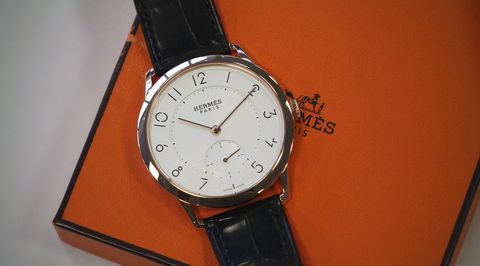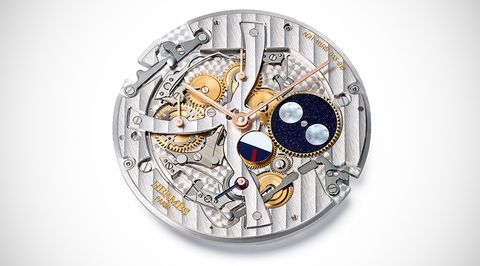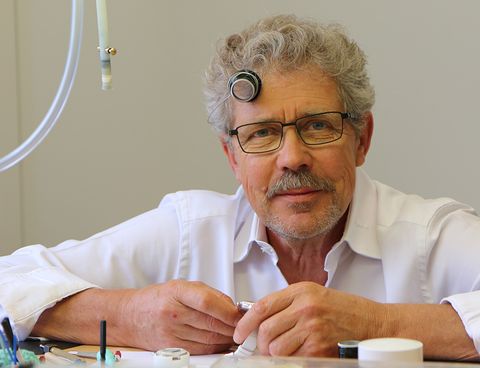
Claude Joray
Slimmer than the average: why Hermes' perpetual calendar is the most important watch it has made
With the Slim d’Hermès, the luxury maison has drawn on a network of horological resources to create one of the outstanding watches of 2015
A few years ago, I remember chatting with Guillaume de Seynes, a member of the Hermès family and of the company’s board, about the recent acquisitions of a dial company, a case manufacturer and a 25 per cent stake in a movement supplier, Vaucher Manufacture Fleurier. When I asked him why, he didn’t mention watches in his reply; rather he told me about Hermès’ famed silk scarves. In the 1940s, the firm was as famous for its scarves as now, but then there were 30-plus suppliers: various companies imported the silk yarn, other firms wove the silk, others printed the scarves while someone else did the hand rolling of the edges. Now, Hermès owns and operates every facet of its scarf production; he told me that in the luxury industry the one thing your clients demand is consistency, and you can only obtain that via complete control – and with that control also comes the flexibility to do interesting things.
In the watch world, one of the most interesting “things” of the past year has been the Slim d’Hermès: a hit at Baselworld and, in its exceptional perpetual calendar guise, a winner in its category at November’s Grand Prix d’Horlogerie de Geneve. A relaxed dress watch that comes both in women’s and men’s sizes, it’s notable in particular for its airy dial aesthetic, with an exclusive stencil-style font for the numerals, designed by Parisian graphic designer Philippe Apeloig.
“Slim, elegant, discreet,” is how Laurent Dordet, CEO of La Montre Hermès, describes the brief that went to design director Philippe Delhotal. Hermes has tended towards watches that mix delicacy with statement-making flourishes – consider the square Cape Cod with its extended, curving lugs, or the similarly bold lugs and “dancing” numerals of the Arceau line. This would be something more universally wearable and conventional, however – and the starting point would be a slim profile requiring a very thin movement.
Often mistakenly assumed to be owned by Parmigiani, Vaucher Manufacture Fleurier is in fact majority owned by the Sandoz Foundation (Sandoz being one of Switzerland’s largest pharmaceutical companes), and makes movements for Richard Mille and other, anonymous brands besides Hermes and Parmigiani.
Behind Parmigiani and Vaucher lies a totally integrated group of companies capable of doing any task within watchmaking – making dials, cases, balances and hairsprings and other components. Such broad resources means Vaucher is not constrained by having to make its movements accept externally supplied components. When Hermès suggested an ultra-slim caliber, therefore, Vaucher could start from the proverbial blank sheet.
What resulted from this collaboration is the H1950, a self-winding (via a smartly recessed micro-rotor) three-hand caliber with a next-to-nothing height of just 2.6mm. With 42 hours power reserve and a free-sprung balance oscillating at 3Hz, it’s an impressive package, that looks the part: the finish is a combination of traditional and modern, with a beautifully polished anglage applied to the edges of the plates while on the surface, instead of Geneva stripes, the pattern is a series of interlocking H’s.
Caliber H1950 also serves as the base movement for the hero piece of the Slim d’Hermès collection, the brand’s first perpetual calendar – like the overall design, another reflection of La Montre Hermès nudging itself towards chic conventionality. With its handful of existing complicated pieces Hermes has gone for unusual, playful concepts; perhaps the best known is 2011’s Arceau Temps Suspendu, a watch that personifies Dordet’s statement to me that “we try to be serious in what we do, but not to take ourselves seriously”.
Many QP readers will know it: it’s a two-handed watch with a retrograde calendar at the 5 o’clock position, but at the touch of a button the hands will go into stasis either side of the 12 while the movement keeps running – allowing you to sit back and enjoy a long lunch, for instance, untroubled by passing time – only to swing back to their correct position when the button is pressed again.
Perhaps Hermès is simply ready, in fact, to take itself as seriously as an integrated, sophisticated watch manufacturer should do – a world-beating perpetual calendar rather than another funky amusement certainly suggests so. But in achieving it, Hermes has applied its customary freshness both in design and technical content, the latter via the genius behind the Temps Suspendu (which amazingly just used a module on a basic ETA movement)– Jean-Marc Wiederrecht’s company Agenhor.
Wiederrecht and his team have built movements and modules for clients as varied as Harry Winston, Van Cleef & Arpels, Fabérgé, Romain Jerome and MB&F. What marks it out from most other firms – including Vaucher, for instance – is its method of operation: it doesn’t actually make anything. Rather, it designs everything in-house, using the most modern CAD facility I’ve ever seen. A small army of specialist sub-contractors then manufactures each part and delivers it to Agenhor’s modern plant in Meyrin, where its watchmakers do the assembly.
What Wiederrecht and co have come up with for the Slim d’Hermès is truly special. The perpetual calendar is the most useful of complications, the original “wear it and forget it” watch – until, that is, you want to travel with one. The problem is you can’t turn them back a day, which you regularly need to if you travel west across the International Date Line. But that isn’t a problem with the Slim d’Hermès perpetual calendar, as it includes a second time zone dial along with all the expected indicators, and it manages this in a module which is only 1.4mm thick. When the module is stacked on top of the H1950, it’s 4mm thick – a supremely skinny engine for a self-winding perpetual calendar with the addition of a second time zone and day/night indicator.
But this is a watch in which lightness of touch is the defining factor across the different parts of its design, as Delhotal explained. “The important thing is the balance between the different aspects of the watch. It isn’t just the case or the dial colour or the typography – it is how all of them go together in harmony that makes the watch.”
The case and the typography were in fact worked on at the same time, Apeloig, who has worked with Hermes on previous projects but not on watches, coming up with the unique typeface. What makes this work perfectly is the use of white space breaking up the forms of the numbers. There is enough of the outline visible for the eye to quickly read and understand the numbers, but they are broken up in such a way as to appear playful on the dial. It makes what is otherwise a very simple dial in the three-hand versions, and a very traditional one in the perpetual calendar, seem not in the least austere.
“It’s like music and an orchestra”, says Delhotal. “The best results come when all the players work together.” The collective efforts from a broad group of collaborators have produced one of the most accomplished new watches of 2015, and one that richly deserved its victory at the GPHG as the best calendar watch of the year.




Great tip and more realistic content much magnificent to read and i am really looking for more post. North Brisbane wreckers is one of the most predominant company in automobile industry serving cash for cars north brisbane and scrap car removal to the customers. Avail us for more information
ReplyDeleteOutstanding article, impressive content keep sharing your thoughts thank you. Want to buy a new car sell the previous one question arises where and how? Well cash for cars is platform who purchase your car or any vehicle what are you waiting for just check out our services brisbane auto wreckers contact us and make money
ReplyDeleteThere are a lot of articles on this topic but I think your article is best you explained it very well. The presentation you provided was attractive. I really appreciate this effort. Thank you so much. Are you searching for the best rental cars service in Dubai? We provide the best services for luxurious rental cars you can contact us easily.
ReplyDeletelambo rental dubai